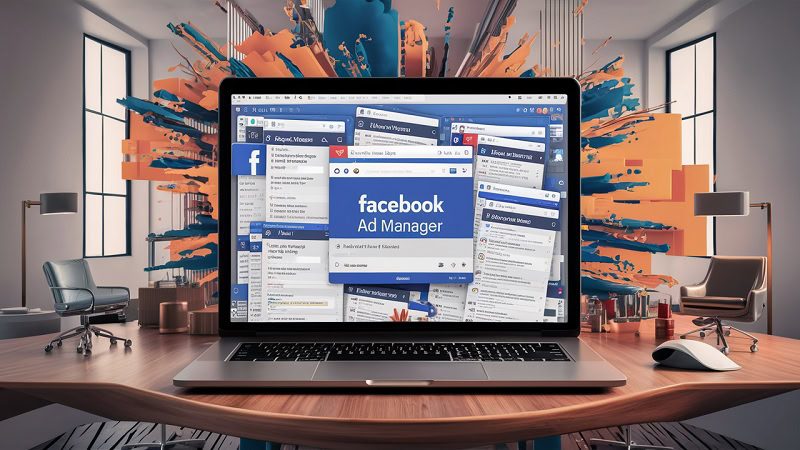
About author: Jack Evans brings his extensive experience in digital marketing to the table, specialising in paid social strategies that drive growth for e-commerce and DTC brands.
Many business owners and marketers struggle to get their Facebook ad campaigns off the ground, let alone turn them into profit-generating machines.
However, mastering Facebook ads can be a game-changer for your business. With over 2.8 billion monthly active users, Facebook offers unparalleled access to potential customers. Yet, the platform’s complexity and constant changes can leave even experienced marketers feeling overwhelmed.
Facebook advertising has the potential to revolutionise your marketing efforts, but only if you know how to use it effectively. The key lies in understanding the platform’s nuances and implementing strategies that align with your business goals.

Boost E-Commerce ROI: Download Our Free CPA & ROAS Calculator
This guide will walk you through everything you need to know about managing Facebook ads effectively. From setting up your first campaign to optimising for maximum ROI, we’ve got you covered.
By the end of this article, you’ll be equipped with the knowledge and tools to turn your Facebook ad frustrations into fantastic results.
Now, let’s cut right to the chase.
Ready to elevate your business? Check out our Facebook marketing company and see how we can help you achieve incredible results!

Setting Up Your Facebook Ad Campaign
Before you can start reaping the rewards of Facebook advertising, you need to lay the groundwork. Setting up your campaign correctly is crucial for success. Let’s break down the process step by step.
First things first, you’ll need a Facebook Business Manager account. This is your command centre for all things Facebook advertising. If you haven’t set one up yet, head over to business.facebook.com and follow the prompts. It’s straightforward and won’t take more than a few minutes.
Once you’re in Business Manager, it’s time to create your first campaign. Click on the ‘Campaigns’ tab and then ‘Create’. Facebook will ask you to choose a campaign objective. This is a critical decision that will shape your entire ad strategy.
Are you looking to boost brand awareness? Generate leads? Drive traffic to your website? Pick the objective that aligns most closely with your business goals.
Next up is audience targeting. This is where Facebook’s wealth of user data really shines. You can target people based on demographics, interests, behaviours, and even life events.
But be careful not to narrow your audience too much. A good rule of thumb is to aim for an audience size of at least 500,000 people for most campaigns.
Now, let’s talk budget. Facebook gives you two options: daily budget or lifetime budget. Daily budget is great if you want to spread your spending evenly over time.
Lifetime budget works well for campaigns with a fixed end date. How much should you spend? Start small and scale up as you see results. Even £5 a day can get you started.
Creating Compelling Facebook Ads
With your campaign structure in place, it’s time to create ads that stop scrollers in their tracks. The key to effective Facebook ads is understanding what makes your audience tick. What problems do they have that your product or service can solve? What desires can you tap into?
Let’s start with visuals. Facebook is a visual platform, so your ad images or videos need to pop. Bright colours, faces, and unusual images tend to perform well. But don’t just rely on stock photos. Authentic, original images often outperform polished, corporate-looking visuals.
What about ad copy? Keep it short and snappy. Facebook users have short attention spans, so get to the point quickly. Start with a hook that grabs attention, then follow up with your value proposition. Why should someone click on your ad? What’s in it for them?
Don’t forget about your call-to-action (CTA). Facebook offers several pre-set CTAs like ‘Learn More’, ‘Shop Now’, or ‘Sign Up’. Choose the one that best fits your campaign objective. And make sure your landing page matches your ad. Nothing kills conversions faster than a disconnect between what your ad promises and what your website delivers.
Testing is crucial in ad creation. Don’t just create one ad and hope for the best. Create multiple variations with different images, headlines, and body copy. Facebook’s split testing feature makes it easy to see which combinations perform best.
Keep in mind, the perfect ad doesn’t exist. What works today might not work tomorrow. Keep testing and iterating to stay ahead of ad fatigue and changing consumer preferences.
Mastering Facebook Ad Targeting
Targeting is where the rubber meets the road in Facebook advertising. Get it right, and you’ll reach the people most likely to become customers. Get it wrong, and you’ll waste your budget on uninterested scrollers.
Facebook offers a mind-boggling array of targeting options. Let’s start with the basics: age, gender, and location. These are your foundational targeting parameters. But don’t stop there. Explore interests and behaviours to really hone in on your ideal customer.
Interested in reaching fitness enthusiasts? Target people who follow gym pages or have recently purchased workout equipment. Selling luxury products? Look for high-income earners with an interest in designer brands. The possibilities are endless.
But here’s a pro tip: don’t go too narrow with your targeting. It’s tempting to try and create the perfect audience, but overly specific targeting can limit your reach and drive up costs. Strike a balance between specificity and scale.
Custom audiences are another powerful targeting tool. These let you reach people who’ve already interacted with your business. You can create custom audiences from your customer list, website visitors, or people who’ve engaged with your content on Facebook.
Once you’ve got a custom audience, take it a step further with lookalike audiences. These are groups of Facebook users who share similar characteristics with your custom audience. It’s like cloning your best customers and finding more people just like them.
Also, consider retargeting. This lets you show ads to people who’ve visited your website or interacted with your Facebook page. Retargeting can be incredibly effective, often delivering higher conversion rates at a lower cost.
Optimising Your Facebook Ad Budget
Now that you’ve got your ads up and running, it’s time to make sure you’re getting the most bang for your buck. Budget optimisation is all about maximising your return on ad spend (ROAS).
First, let’s talk about bidding strategies. Facebook offers several options, including lowest cost, target cost, and highest value. Lowest cost is great when you’re starting out. It lets Facebook automatically adjust your bids to get the most results within your budget.
As you get more advanced, you might want to try target cost bidding. This lets you set a target cost per result, giving you more control over your spending. Highest value bidding is ideal for e-commerce businesses looking to maximise sales revenue.
Keep a close eye on your frequency. This metric shows how often the average person in your audience sees your ad. If it gets too high, you risk annoying people and wasting money. Aim to keep your frequency below 3 for most campaigns.
Don’t be afraid to adjust your budget based on performance. If a campaign is crushing it, consider increasing the budget to capitalise on its success. Conversely, if a campaign is underperforming, it might be time to pause it and reassess.
Be aware that Facebook’s algorithm needs time to optimise. Don’t make drastic changes to your campaigns too quickly. Give them at least a few days to gather data before making big adjustments.
Lastly, consider using Facebook’s automated rules. These let you set up automatic adjustments to your campaigns based on performance thresholds. For example, you could create a rule to increase your budget by 20% if your cost per result drops below a certain level.
Tracking and Analysing Your Facebook Ad Performance
You can’t improve what you don’t measure. That’s why tracking and analysing your Facebook ad performance is crucial for long-term success. Let’s explore the metrics that matter and how to use them to optimise your campaigns.
Facebook’s Ads Manager is your go-to tool for performance tracking. It provides a wealth of data on your campaigns, ad sets, and individual ads. But with so much information available, it’s easy to get overwhelmed. Focus on the metrics that align with your campaign objectives.
If your goal is brand awareness, keep an eye on reach and frequency. For engagement campaigns, look at likes, comments, and shares. If you’re driving traffic to your website, click-through rate (CTR) is key. And for conversion-focused campaigns, cost per conversion and return on ad spend (ROAS) are your North Star metrics.
Don’t just look at the numbers in isolation. Compare your performance over time and against industry benchmarks. Are your costs per click decreasing? Is your conversion rate improving? These trends can give you valuable insights into the effectiveness of your strategy.
Facebook’s attribution window is another important factor to consider. By default, Facebook uses a 7-day click and 1-day view attribution model. This means conversions are credited to your ad if they happen within 7 days of someone clicking on it, or within 1 day of viewing it without clicking. Understanding this can help you better assess the true impact of your ads.
Take advantage of Facebook’s split testing feature to compare different ad elements. Test different images, headlines, or targeting options to see what resonates best with your audience. Just make sure to test one variable at a time for clear results.
Finally, don’t overlook the Facebook Pixel. This powerful tool allows you to track actions people take on your website after clicking on your ad. It’s essential for measuring conversions and creating retargeting audiences.
Advanced Facebook Ad Strategies
Ready to take your Facebook advertising to the next level? Let’s explore some advanced strategies that can help you squeeze even more value out of your campaigns.
First up, consider using Facebook’s Campaign Budget Optimisation (CBO). This feature allows Facebook’s algorithm to automatically distribute your budget across ad sets to get the best overall results. It can be particularly effective for campaigns with multiple ad sets targeting different audiences.
Dynamic ads are another powerful tool, especially for e-commerce businesses. These ads automatically show products from your catalogue based on user behaviour. For example, you can retarget someone with an ad for a product they viewed on your website but didn’t purchase.
Video ads are becoming increasingly popular on Facebook, and for good reason. They’re engaging, shareable, and can convey a lot of information quickly. Consider creating short, attention-grabbing videos to showcase your products or tell your brand story.
Messenger ads are an often overlooked opportunity. These ads appear in the Facebook Messenger app and can be a great way to start conversations with potential customers. They work particularly well for businesses that rely on personal interaction, like service providers or local shops.
Don’t underestimate the power of user-generated content (UGC). Ads featuring real customer photos or testimonials often outperform polished, professional content. They add authenticity and social proof to your marketing messages.
Lastly, consider using Facebook’s Automated App Ads if you’re promoting a mobile app. These use machine learning to optimise your ad creative and targeting for app installs or engagement.
Staying Compliant with Facebook Ad Policies
Navigating Facebook’s advertising policies can feel like walking through a minefield. But understanding and adhering to these rules is crucial for maintaining a successful ad account. Let’s break down the key points you need to know.
First and foremost, Facebook prohibits ads for illegal products or services. This might seem obvious, but it also includes products that are legal in some places but not others, like certain supplements or financial services. Always check the regulations in your target locations.
Misleading or false content is a big no-no. Your ads must accurately represent your product or service. No clickbait, no exaggerated claims, and definitely no false promises. Be honest about what you’re offering and what customers can expect.
Facebook has strict policies around personal attributes. You can’t imply knowledge of someone’s personal characteristics, like their race, religion, or sexual orientation. This applies even if your targeting is based on those attributes.
If you’re running ads related to social issues, elections, or politics, you’ll need to go through a special authorisation process. These ads are subject to additional transparency requirements.
Be careful with your ad imagery. Facebook prohibits excessive skin or nudity, violence, and shocking or sensational content. Even if your product is related to these topics, your ads need to be tasteful and non-explicit.
Keep an eye on your landing pages too. Facebook doesn’t just look at your ad content, they also check where your ad leads. Make sure your landing pages comply with their policies and provide a good user experience.
As a final note, Facebook’s policies are constantly evolving. Stay up to date by regularly checking their Advertising Policies page. When in doubt, err on the side of caution. It’s better to play it safe than risk having your ad account suspended.
Managing Facebook Ads effectively is no small feat, but with the right knowledge and strategies, it can be an incredibly powerful tool for growing your business. From setting up your campaigns and creating compelling ads to optimising your budget and staying compliant with Facebook’s policies, there’s a lot to master.
Success with Facebook advertising doesn’t happen overnight. It requires patience, continuous learning, and a willingness to adapt to changing trends and algorithms.
But with persistence and the insights you’ve gained from this guide, you’re well on your way to Facebook ad success.







